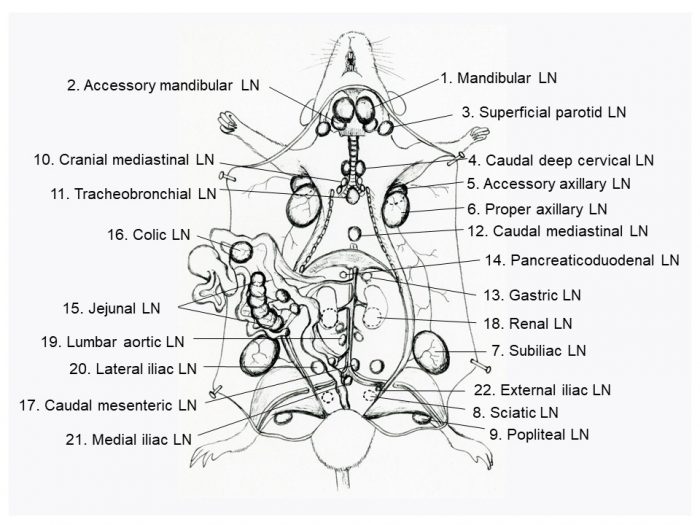Lymph nodes in mice
2021.03.30 note
There are 22 types of lymph nodes in the mouse [1].
Lymph nodes in normal mice are about 1-2 mm in diameter and are difficult to see with
the naked eye.
In the MXH10/Mo-lpr/lpr (MXH10/Mo/lpr) mice established in our laboratory, lymph nodes swell to about 10 mm in diameter (about the size of human lymph nodes).
The location of the lymph nodes can be easily identified.
The characterization of the lymphatic system in mice will help develop diagnosis and treatment modalities for diseases related to the human lymphatic system.
When using animal models, the significance of animal model choice, the factors of variation and phenotype-specific to the animal model, control conditions and statistical processing should be considered [2].
The results obtained should be accurately described, understood and discussed.

The nomenclature and location of lymph nodes (LNs) are based on the description of Van den Broeck et al. [3]. We coined a new name for the caudal deep cervical LN (No. 4) since this LN position was lower than described by Van den Broeck et al. [3].
No. 1–9: peripheral (head and neck region, forelimb, hindlimb) LNs.
No. 10–12: intra-thoracic LNs.
No. 13–22: intra-abdominal LNs.
No. 11–16 and No. 21 LNs are isolated.
No. 17 LNs are merged together, and were counted as one.
LNs other than those above are located bilaterally and symmetrically
References
[1] L. Shao, S. Mori, Y. Yagishita, T. Okuno, Y. Hatakeyama, T. Sato, T. Kodama, Lymphatic mapping of mice with systemic lymphoproliferative disorder: usefulness as an inter-lymph node metastasis model of cancer, Journal of immunological methods, 389 (2013) 69-78.
[2] W. Van den Broeck, A. Derore, P. Simoens, Anatomy and nomenclature of murine lymph nodes: Descriptive study and nomenclatory standardization in BALB/cAnNCrl mice, Journal of immunological methods, 312 (2006) 12-19.
[3] M.J. Justice, P. Dhillon, Using the mouse to model human disease: increasing validity and reproducibility, Disease Models & Mechanisms, 9 (2016) 101-103.